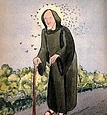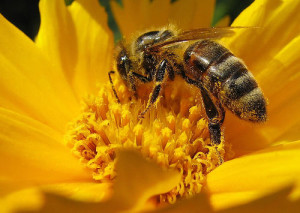
Sumary: St Modhomhnóg
The names of Irish saints often have the prefix “mo” (= “my”, “little”, “dear”) attached to them, indicating endearment or affection, so Domhnoc or “Dominic” is likely to have been this saint’s original name. The Latin word Dominicus means “belong to the Lord”. So one could paraphrase his name as “my little one that belongs to the Lord“.
Patrick Duffy traces the names and stories told about him.
Studied with St David in Wales
 Modhomhnoc seems to have come from the royal line of the Uí Néill of Ulster. He went to study at the monastery of St David at Menevia in Wales, where he cultivated the flowers in the garden and kept the bees. One story from there is that Modhomhnóg was working with another monk one day making a road, when he had to rebuke him for some matter. The other monk was seized with anger and took up a crowbar, but before he could bring it down on Modhomhnóg, David, who saw the incident, miraculously held back the angry monk’s arm by his spiritual powers and it remained paralysed.
Modhomhnoc seems to have come from the royal line of the Uí Néill of Ulster. He went to study at the monastery of St David at Menevia in Wales, where he cultivated the flowers in the garden and kept the bees. One story from there is that Modhomhnóg was working with another monk one day making a road, when he had to rebuke him for some matter. The other monk was seized with anger and took up a crowbar, but before he could bring it down on Modhomhnóg, David, who saw the incident, miraculously held back the angry monk’s arm by his spiritual powers and it remained paralysed.
Bees to Ireland
 According to Rhygyfarch’s Life of David, the bees were so attached to Modhomhnóg that when it came to the time for him to return to Ireland, they swarmed around him and the ship that was carrying him and, though he tried to return them to their rightful owner, David eventually blessed the bees and allowed them to go with Modhomhnóg. This story is confirmed by Oengus in the entry in his Féilire: “In a little boat from the east over the pure-coloured sea, my Domhnoc brought … the gifted race of Ireland’s bees.” Saint Gobnait, however, is also said to have kept bees in Ballyvourney around the same time!
According to Rhygyfarch’s Life of David, the bees were so attached to Modhomhnóg that when it came to the time for him to return to Ireland, they swarmed around him and the ship that was carrying him and, though he tried to return them to their rightful owner, David eventually blessed the bees and allowed them to go with Modhomhnóg. This story is confirmed by Oengus in the entry in his Féilire: “In a little boat from the east over the pure-coloured sea, my Domhnoc brought … the gifted race of Ireland’s bees.” Saint Gobnait, however, is also said to have kept bees in Ballyvourney around the same time!
 A bee-garden in Bremore, Balbriggan
A bee-garden in Bremore, Balbriggan
When Modhomhnóg landed back to Ireland, he set up a church at a place called Bremore, near Balbriggan, in County Dublin, and here he established the bees in a happy garden just like the one they had in Wales. The place is known to this day as “the Church of the Beekeeper”, though it is also associated with St Molaga, who went there to control the bees that Modhomhnóg had brought.
A hermitage in Kilkenny
Modhomhnóg eventually made a hermitage for himself at Tibraghny in south-west Kilkenny. Some say he became bishop (or abbot) of Ossory after Moling. Pádraig Ó Riain in his recent A Dictionary of Irish Saints gives his name as Modhomhnóg Oilithir. Oilithir means ‘pilgrim’ and this may indicate how Modhomhnóg came to be in Wales with St David in the first place.